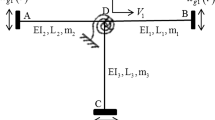Abstract
The damping characteristic of a specific type of high-strength alloys was researched by using a dynamic mechanical analyzer (DMA) and via the application of viscoelastic damping theory. The characteristics of temperature/frequency-dependent damping and coupling factor are provided from the perspective of dynamic applications. Consider the evolution of damping characteristics. The evolution can be expressed as a time-dependent term and a non-time-dependent term. This time-dependent-term variable damping nonlinear stochastic dynamic analysis method was proposed according to the random vibration of magnesium alloy structures. The quasi-non-stationary random analysis method of stationary problems was established based on the solution characteristics of the pseudo-excitation method. In contrast, from the numerical analysis results and experiments conducted on magnesium alloy structures, it is demonstrated that the analysis results of constant damping systems have obvious inconsistencies with the experimental results. The calculation results based on variable damping systems were more consistent with experimental results. It is suggested that variable damping theory should be used in the dynamic structural analysis of the magnesium alloy material under consideration in fields and applications with higher accuracy requirements.















Similar content being viewed by others

References
Liu XL (2012) Study on mechanical properties and damping capacities of mg-Zn-Nd-Zr alloy [D]. Central South University
Liu YF, Liu CM, Gao YH et al (2019) Influence of strain on microstructure and mechanical properties for forged mg-Gd-Y-Zn-Zr alloy[J]. Forging & Stamping Technology 4(44):145–150,161
Silva RX, Nonato A, Moreira RL, Almeida RM, Paschoal CWA (2020) High-temperature structural phase transition and infrared dielectric features of La2CoMnO6[J]. Mater Res Bull 129(110878):1–8
Li LB (2021) A micromechanical temperature-dependent vibration damping model of fibre-reinforced ceramic-matrix composite[J]. Compos Struct 261(113297):1–15
Li LB (2020) A time-dependent vibration damping model of fiber-reinforced ceramicmatrix composites at elevated temperature[J]. Ceram Int 46:27031–27045
Ebrahimi M, Zhang L, Wang QD, Zhou H, Li WZ (2021) Damping characterization and its underlying mechanisms in CNTs/AZ91D composite processed by cyclic extrusion and compression[J]. Materials Science & Engineering A 821(141605):1–9
Hamdaoui M, Ledi KS, Robin G, Daya EM (2019) Identification of frequency-dependent viscoelastic damped structures using an adjoint method[J]. J Sound Vib 453:237–252
Zhou Y, Liu AN, Xu YZ, Guo YL, Yi XS, Jia YX (2021) Frequency-dependent orthotropic damping properties of Nomex honeycomb composites[J]. Thin-Walled Struct 160(107372):1–8
Kuo CH, Huang JY, Lin CM, Chen CT, Wen KL (2021) Near-surface frequency-dependent nonlinear damping ratio observation of ground motions using SMART1[J]. Soil Dyn Earthq Eng 147(106798):1–17
Ander S, Lothar G (2006) On a critique of a numerical scheme for the calculation of fractionally damped dynamical systems [J]. Mech Res Commun 33:99–107
Liu M, Zuo DL, Jones NP (2013) Analytical and numerical study of deck-stay interaction in a cable stayed bridge in the context of field observations [J]. J Eng Mech 139(11):1636–1652
Adessina A, Hamdaoui M, Xu C, Daya EM (2016) Damping properties of bi-dimensional sandwich structures with multi-layered frequency-dependent visco-elastic cores [J]. Compos Struct 154:334–343
Sun PX, Yang H, Zhao Y (2020) Time-domain calculation method of improved hysteretic damped system based on frequency-dependent loss factor [J]. J Sound Vib 488(115658):1–18
Li CD, Chen MJ, Ge XG (2021) A simple closed response solution to random ground motion for exponential non-viscous-damping structures based on the Clough-Penzien Spectrum excitation [J]. Appl Math Mech 42(3):282–291
Lunden R, Dahlberg T (1982) Frequency-dependent damping in structural vibration analysis by use of complex series expansion of transfer functions and numerical Fourier transformation [J]. J Sound Vib 80(2):161–178
Lin JH, Zhang YH, Li XS et al (2004) Seismic spatial effects for long-span bridges using the pseudo excitation method[J]. Eng Struct 26(9):1207–1216
Xu WT, Zhang YH, Lin JH et al (2011) Sensitivity analysis and optimization of vehicle-bridge systems based on combined PEM–PIM strategy[J]. Comput Struct 89:339–345
Conflict of Interest
The authors state no conflict of interest.
Data Availability Statement
All data generated or analysed during this study are included in this published article.
Author information
Authors and Affiliations
Corresponding author
Additional information
Publisher’s Note
Springer Nature remains neutral with regard to jurisdictional claims in published maps and institutional affiliations.
Rights and permissions
About this article
Cite this article
Xu, W., Pan, F., Liu, H. et al. The Characteristics of Temperature/Frequency-Dependent Damping and Quasi-Non-Stationary Random Dynamic Method. Exp Tech 47, 343–353 (2023). https://doi.org/10.1007/s40799-021-00531-8
Received:
Accepted:
Published:
Issue Date:
DOI: https://doi.org/10.1007/s40799-021-00531-8



